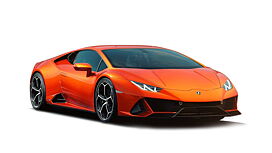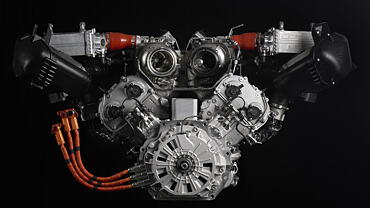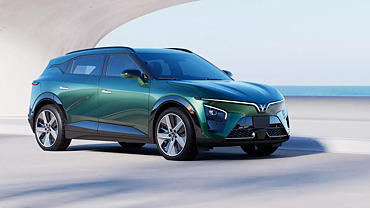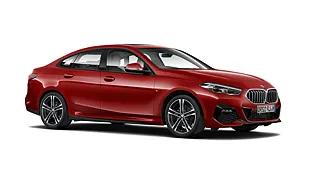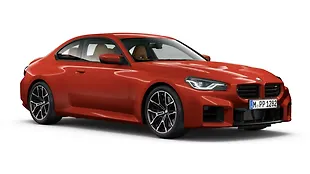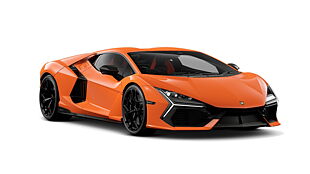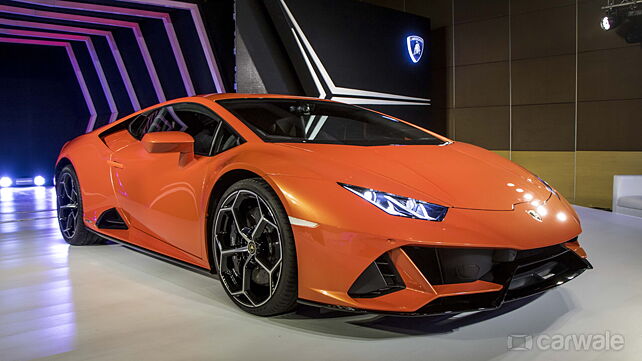
The Huracan Evo is based on the prowess and performance of the Performante and incorporates the next-generation vehicle dynamic control and aerodynamics, says Lamborghini. But the Evo truly is the newest iteration of the Huracan which carries all the technical bits from the ‘Ring record holder and its elder sibling, while also debuting a touchscreen system for the Baby Lambo. Officially revealed in early January, the Evo is already on sale in India for a price tag of Rs 3.7 crore. Here is a picture gallery of the Huracan Evo to drool over.

Sitting behind the driver is the same naturally-aspirated V10 which powers the Performante. It was earlier rumoured to get a bump in output for the Evo.

But Lamborghini decided otherwise. So, the 5.2-litre still produces the 631bhp of max power at a screaming 8,000rpm and 600Nm of twisting force.

Tipping the scales at 1,422 kg, the Evo can accelerate from 0-100kmph in 2.9 seconds and do 0-200kmh in blazingly quick 9.0 seconds. The top speed is 325kmph.

The Huracan Evo adopts technologies such as four-wheel steering and torque vectoring system as a Part of the LDVI (Lamborghini Dinamica Veicolo Integrata).

The 2.0 version of Lamborghini Piattaforma Inerziale (LPI) monitors the dynamic attitude like lateral, longitudinal and vertical accelerations, roll, pitch and yaw rate.

Lamborghini has also plonked the Enhanced Lamborghini Dynamic Steering (LDS) active steering system which works in conjunction with rear-wheel-steering.

The combination of all these systems is governed by LDVI to lend the Evo a super-agile handling and unparalleled level of control.

The ANIMA controller (which in now Lambo’s new system) has three drive modes – Strada, Sport and Corsa.

Appearance wise, the Evo gets a new front bumper which makes it all the more distinct from the Performante.

The enlarged air intakes with integrated wing feature the Ypsilon shape is characteristic to Lamborghini design.

At the back, there is a new engine cover. Then there are those two circular exhausts sticking out at the back combined with massive lower diffusers which looks menacing.

The Performante has a raucous exhaust note, and the repositioned lightweight manifold makes the Evo sound even better.

Moreover, the massive rear wing of the Performante is absent and it is replaced by a petite duck-lip spoiler which provides enhanced air flow.

The newly integrated aerodynamics styling of the Huracan Evo has improved downforce and aerodynamic efficiency by more than five times over the standard version.

The stylish 20-inch Aesir Y-spoke alloys add to the aggressive styling. And the wheels show the massive carbon ceramic – with two callipers – in all its glory.

When Lamborghini launched the Huracan in 2014, the cabin was sans any screen in the well-laid-out centre console to keep things timeless.

Now with the Evo, the touchscreen has debuted in the Huracan. The 8.4-inch HMI capacitive touchscreen is identical to the one seen in the Centenario.

This system comes with smartphone integration, voice command and navigation as a standard feature. It also controls various other vehicle functions.

But the most interesting bit of hardware in the system is the optional dual-camera telemetry system.

This allows an advanced telemetry recording and analysis of the drive if the owner decides to take it on a race track.

The interior features a dedicated new EVO trim in Alcantara and leather mix, with Arancio Dryope details matching the body tone.

The sporty trims feature a number of bi-colour options wrapped in Alcantara option. Lightweight materials such as Lamborghini's patented Carbon Skin are also available.

The new Evo is the seventh iteration of Huracan in India. And what’s more, it is cheaper than the Performante and way cheaper than the LP610-4 Spyder.

Speaking of Spyder, the Huracan Evo Spyder will surely debut sometime in the next few months, with a prompt Indian debut too.

In India, it goes up against the likes of the Porsche 911, Ferrari 488, Audi R8, Mercedes-Benz AMG GT, and the Maserati GranTurismo.
Pictures by Kaustubh Gandhi

